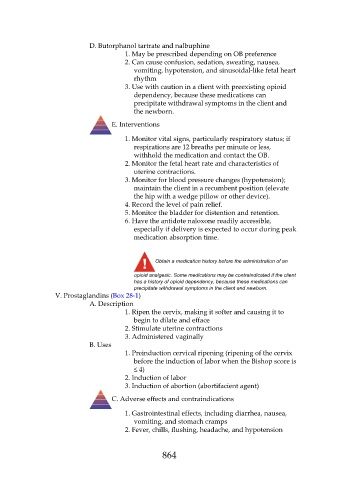Page 864 - Saunders Comprehensive Review For NCLEX-RN
P. 864
D. Butorphanol tartrate and nalbuphine
1. May be prescribed depending on OB preference
2. Can cause confusion, sedation, sweating, nausea,
vomiting, hypotension, and sinusoidal-like fetal heart
rhythm
3. Use with caution in a client with preexisting opioid
dependency, because these medications can
precipitate withdrawal symptoms in the client and
the newborn.
E. Interventions
1. Monitor vital signs, particularly respiratory status; if
respirations are 12 breaths per minute or less,
withhold the medication and contact the OB.
2. Monitor the fetal heart rate and characteristics of
uterine contractions.
3. Monitor for blood pressure changes (hypotension);
maintain the client in a recumbent position (elevate
the hip with a wedge pillow or other device).
4. Record the level of pain relief.
5. Monitor the bladder for distention and retention.
6. Have the antidote naloxone readily accessible,
especially if delivery is expected to occur during peak
medication absorption time.
Obtain a medication history before the administration of an
opioid analgesic. Some medications may be contraindicated if the client
has a history of opioid dependency, because these medications can
precipitate withdrawal symptoms in the client and newborn.
V. Prostaglandins (Box 28-1)
A. Description
1. Ripen the cervix, making it softer and causing it to
begin to dilate and efface
2. Stimulate uterine contractions
3. Administered vaginally
B. Uses
1. Preinduction cervical ripening (ripening of the cervix
before the induction of labor when the Bishop score is
≤ 4)
2. Induction of labor
3. Induction of abortion (abortifacient agent)
C. Adverse effects and contraindications
1. Gastrointestinal effects, including diarrhea, nausea,
vomiting, and stomach cramps
2. Fever, chills, flushing, headache, and hypotension
864

